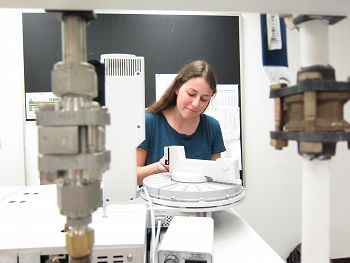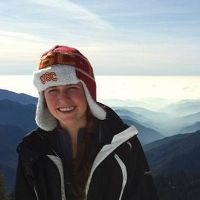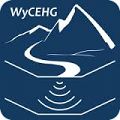Critical Zone Profile - LINDSAY ARVIN (geomorphologist, PhD student)
Geomorphology is the study of all of the different processes that have contributed, and will continue to contribute, to the shape of the Earth. These processes are tied both to the bedrock, which was formed and exhumed a long time ago, and to the vegetation that grows on the bedrock, along with many other factors.
Working at the Southern Sierra CZO, Lindsay Arvin will look at the processes within the critical zone that govern where vegetation grows, what kind of vegetation can grow, and the impacts that this vegetation has on erosion – both chemical and physical – of the Sierras. Studying links between bedrock, vegetation, and erosion, Arvin hopes to interpret the intricate role that bedrock has on shaping the Earth.
“I think the skills I will acquire through my doctoral research are applicable to some very urgent issues, including drought, threats to ecosystems, maintenance of fertile soils, and preservation of iconic landscapes.” – Lindsay Arvin
When I went to the University of Southern California (USC) and started studying geology, I was surrounded by some of the most dramatic landscapes in the world: the Sierra Nevada, Death Valley, the Mojave Desert, and Baja California, to name a few. I realized through taking many geology courses that I was not interested in just one subject, but rather in how different forces working together form the landscapes around me.
Living in California for the past three years, I experienced some of the worst years of drought in its history. I'm genuinely worried about the state’s water supply over the next 5-10 years on a societal level, and also about the impacts a sustained drought could have on natural habitats throughout the region.
At USC I did research in Professor Sarah Feakins’ lab, contributing to an ongoing project on organic biomarkers in plants, soils, and stream waters along the Amazon River and its headwaters. I researched modern biomarker abundance and isotopic composition in several different species of plants.
Organic biomarkers are specific lipids produced in plant waxes. These plant waxes are buried in sedimentary deposits over time, building up in chronological order for a given catchment. Stable isotopes within the biomarkers allow scientists to interpret past environmental changes based on the isotopic signals at different times. Studying them in lake sedimentary records has helped reconstruct environmental changes in the past, and studying them in the modern context helps researchers understand the processes that make biomarkers a good proxy for environmental change.
At the University of Wyoming, I will begin working with Professor Cliff Riebe in the Geology Department in fall 2015. While I was applying to the University of Wyoming to work with Dr. Riebe and the SSCZO, I applied for and was awarded an NSF Graduate Research Fellowship. I proposed to numerically link vegetation to erosion rates in the Southern Sierra, highlighting the potential for this research to broaden our understanding of hydrology and ecology in California. This is clearly a huge task, and my research may take a different direction.
Regardless, I think that the driving questions here are significant ones: If erosion is indeed closely linked to vegetation, and if the type or density of vegetation is controlled somewhat by the bedrock, then perhaps bedrock composition has a more intricate role in shaping the Earth than previously thought.
Doing critical zone research in the Sierra Nevada enables me to apply my interests in geomorphology and ecology to issues that are both relevant and important—namely, hydrology and ecological diversity in California and in mountain ranges worldwide.
While my work will be based primarily at the SSCZO, I hope that I'll have the chance to visit some of the other CZOs and see what kind of research is conducted at different observatories, in different climates, and in regions with different environmental concerns.
:: By Linda Copman, staff writer ::
Lindsay Arvin
In Prof. Feakins lab loading samples to measure abundance of long-chain hydrocarbons in leaf wax.
News Category:
RESEARCH |
PEOPLE |
EDUCATION/OUTREACH
Related News
Explore Further








